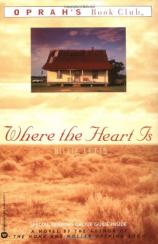Reading Group Guide
Discussion Questions
Where the Heart Is

1. The theme of "home" runs throughout this novel. Would you characterize home as a place, a family, a state of mind, or, as Sister Husband says, a place "where your history begins"? As a homeless person longing for a home, Novalee's image of home is heavily influenced by the images she sees in maga-zines. How influenced are we all by portrayals of home and home life in the media, movies, and on television?
2. In the beginning of the novel, Novalee is a poor, uneducated teenage mother whose own mother abandoned her at a young age. Novalee, however, seems to be remarkably maternal and responsible in her parental role. Do you think this is a believable portrayal of teenage motherhood? Is it possible that lacking a loving mother herself she would be such a good mother? Both Novalee and Lexie defy our stereotypes of poor, single mothers. Do you think this is a strength or a weakness of the novel?
3. Novalee's superstition about the number seven intensifies after the birth of her daughter. What do you make of Novalee's seemingly irrational fears? What role do superstitions play in the lives of even the most rational of us? Are there any other patterns or cycles you recognize in the novel?
4. Despite his cruelty, women are attracted to Willy Jack and are willing to take care of him. What is the attraction of cruel men to needy women? Lexie says, "Girls like us don't get the pick of the litter." What do you think of this statement? And why do you think that Novalee decides to help Willy Jack when she learns of his plight?
5. Willy Jack's story is interspersed throughout the novel. Do you think his story is necessary to the plot? Why or why not? If this novel had been told through the eyes of Willy Jack Pickens, in what ways might we see Novalee differently?
6. Novalee takes pictures to "see something in a way nobody else ever had" and Forney reads to explore the world outside the confines of his own life. Do you think books and photography help them deal with their lives or keep them from dealing with life head on? In what other ways do we use inanimate objects to either cope with life or hide from it?
7. Children play an important role in this novel. How are their stories important? What do each of the children--Americus, Benny, Praline, Brownie--teach us about love and loss of innocence?
8. Despite their struggles, Lexie's family is incredibly loving, fun-filled, and close. This is what makes the attack on Lexie and Brownie so heart wrenching and shocking. Do you think Brownie's trust in adults can ever be fully restored? Why do you think the author decided to include such a brutal scene in a book filled with so much kindness?
9. How did you feel when Novalee spurned Forney? Did you believe they would ultimately end up together? Do you think they are well matched? Do you believe that differences in education and social class matter in a relationship, and what do you think makes it possible to bridge such differences? Or do you believe that people with similar backgrounds tend to be better matched?
10. There are no traditional families in this novel. Why do you think the author chose to write a book about home and family yet disregarded established notions of what constitutes each? Though many of us accept and embrace different forms of family life, why do you think the traditional family is still frequently portrayed as mother/father/children? Do you think this remains the "ideal"?
Where the Heart Is
- Publication Date: June 30, 1998
- Paperback: 376 pages
- Publisher: Warner Books
- ISBN-10: 0446672211
- ISBN-13: 9780733620188






